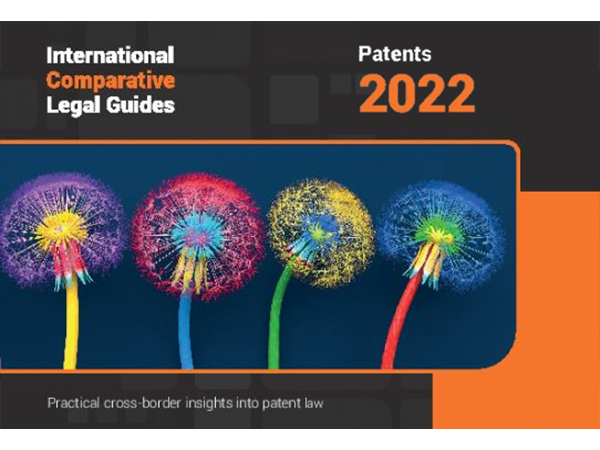
Intellectual Property
Viewpoints
Filter by:
Why No One is Talking About Derivation Proceedings
November 2, 2016 | Blog | By Kevin Amendt
Someone stole your invention and filed for a patent on it? Derivation proceedings in the Patent Office may be an answer. The Leahy-Smith America Invents Act (AIA) amended 35 U.S.C. § 135 to replace interference proceedings with a new process called derivation proceedings.
Read more
Patent-Agent Privilege and the USPTO’s Proposed New Rule
November 1, 2016 | Blog | By Matthew Hurley, Matthew Galica, Anthony Faillaci
Several recent court decisions have shed light on the patent agent privilege, and now the U.S. Patent and Trademark Office (USPTO) is seeking to weigh-in on the issue.
Read more
ITC Institutes “Certain Silicon-on-Insulator Wafers” Investigation – Only the Fourth 100-Day Pilot Program Ordered
October 31, 2016 | Blog | By Michael Renaud, Daniel Weinger
On October 19, 2016, the ITC instituted Investigation No. 1025, based on a complaint filed on May 26, 2016, by Silicon Genesis Corporation (SiGen), against Soitec, S.A. (Soitec). As part of the institution, the ITC ordered that the ALJ issue an early initial determination regarding whether SiGen “has satisfied the economic prong of the domestic industry requirement.”
Read more
Kyle Bass’ First IPR Win At The PTAB
October 28, 2016 | Blog | By Christina Sperry
Since Kyle Bass founded Coalition for Affordable Drugs X LLC (CFAD) to challenge pharmaceutical patents, CFAD has filed numerous petitions with the Patent Trial and Appeal Board (PTAB) of the U.S. Patent and Trademark Office (Office) seeking to institute inter partes review (IPR) proceedings to invalidate a number of pharmaceutical patents, including three patents owned by Anacor Pharmaceuticals, Inc., as previously discussed at Global IP Matters.
Read more
PTAB Vacating Its Initial Institution Decision is Not Appealable, Federal Circuit Says
October 28, 2016 | Blog | By William Meunier
The Federal Circuit reaffirmed last week that the Patent Trial and Appeal Board’s (PTAB’s) decision to discontinue inter partes review (IPR) proceedings is not reviewable on appeal.
Read more
Analyzing Patent Claims Having Conditional Language – the PTAB Provides Clarity
October 21, 2016 | Blog | By Christina Sperry, Monique Winters Macek
The Patent Trial and Appeal Board (PTAB) recently designated Ex parte Schulhauser, Appeal 2013-007847 (PTAB April 28, 2016), as precedential. In this decision the Board clarified how to interpret method and system claims that include conditional language.
Read more
Another Friendly Reminder from the CAFC - Use of "the Present Invention" is Clear and Unequivocal Evidence of Disavowal
October 18, 2016 | Blog | By Michael Van Loy, Nicholas Mouton
Disavowal can occur when a patent holder disavows the full scope of claim terms in the specification or during prosecution (e.g., through the doctrine of prosecution history estoppel). In either event, disavowal requires clear and unequivocal evidence that the claimed invention includes or does not include a particular feature.
Read more
FTC and DOJ Issue Proposed Updates to Antitrust Guidelines for Licensing IP
October 14, 2016 | Blog | By Michael Renaud, Robert Kidwell, Andrew DeVoogd, Marguerite McConihe
For the first time in 26 years, the FTC and DOJ (the “Agencies”) have issued proposed updates to the Antitrust Guidelines for the Licensing of Intellectual Property, last revised in 1995.
Read more
Pleading Standard Defined– CAFC Holds that Joint Infringement Complaint Requires Identification of All Required Claim Steps
October 12, 2016 | Blog | By Adam Samansky, Peter Cuomo
Plaintiffs bringing patent infringement complaints under the Iqbal/Twombly pleading standard should take notice. On September 30, 2016, a panel of the Federal Circuit affirmed a district court’s dismissal of a deficient complaint under Rule 12(b)(6).
Read more
Think Before You Settle: Protegrity Teaches Timing is Important When Negotiating Settlement Agreements
October 4, 2016 | Blog | By William Meunier , Matthew Galica
As a patent owner involved in patent litigation, you must consider numerous factors when negotiating a settlement agreement. An important contemplation is timing, because finalizing a settlement agreement at the wrong juncture of your legal proceedings can have devastating results.
Read more
Five things academic scientists should know when pursuing their first patent - Five-Part Series
October 3, 2016 | Blog | By Ingrid A. Beattie, PhD
We’ll start with the first question a patent attorney might ask you: Have you told anyone about your invention?
Read more
CAFC's Husky Decision Makes Sledding Tougher for Patent Owners in PTAB Appeals
September 30, 2016 | Blog | By William Meunier
The Federal Circuit recently determined that it lacked jurisdiction to review the Patent Trial and Appeal Board’s determination that assignor estoppel has no affect in an inter partes review (“IPR”).
Read more
Explaining the Defend Trade Secrets Act
September 29, 2016 | Blog | By Michael Renaud, Nick Armington
Three attorneys from Mintz Levin’s IP and Employment practices are featured writers in the American Bar Association’s Business Law Today publication, explaining the ins-and-outs of the Defend Trade Secrets Act (DTSA).
Read more
“Processing System” Does Not Render Claims Indefinite
September 29, 2016 | Blog | By Michael McNamara, Michael Renaud
The Federal Circuit relied on Nautilus to preserve functional language of a method claim in a decision published last Friday. In Cox Comm, Inc. v. Sprint, No. 2016-1013, the Federal Circuit held that the term “processing system” did not render the asserted claims indefinite.
Read more
Federal Circuit Revisits Willfulness Post Halo
September 29, 2016 | Blog | By Brad M Scheller , Adam Rizk
On remand from the Supreme Court’s decision in Halo Elecs., Inc. v. Pulse Elecs., Inc., 136 S. Ct. 1923 (2016), the Federal Circuit recently issued a revised decision in Stryker Corp. v. Zimmer, Inc., No. 2013-1668 (Fed. Cir. 2016). The decision provides insight into the court’s interpretation of the Halo standard and enhanced damages.
Read more
In McRO, Federal Circuit Provides Further Guidance on Section 101
September 22, 2016 | Blog | By Michael Renaud, Michael Newman, Matthew Karambelas
Two years after the Central District of California invalidated two 3-D animation patents under Section 101, the Federal Circuit reversed that court’s decision, finding that the lower court oversimplified the claims of a computer-related invention.
Read more
Apotex to Supreme Court: Review BPCIA 180-Day Notice Requirement
September 21, 2016 | Blog | By Thomas Wintner
On September 9, 2016, Apotex Inc. filed a petition for writ of certiorari in the U.S. Supreme Court seeking review of the Federal Circuit’s decision in Amgen Inc. v. Apotex Inc., Case No. 2016-1308.
Read more
Markman at the ITC and Its Effect on an Investigation
September 20, 2016 | Blog | By Michael Renaud, Michael Newman
Several months ago, we were struck with the question of whether, as counsel for a patent owner at the ITC, our clients’ case would benefit from a Markman hearing. Claim construction during an ITC investigation was routinely performed as part of the evidentiary hearing in an investigation, rather than as part of earlier Markman proceedings.
Read more
Federal Circuit: Go whole-hog on validity below if you want to contest an independent determination of invalidity on appeal
September 15, 2016 | Blog | By Michael Newman
Think you’ve won on validity at the U.S. Patent and Trademark Office’s Patent Trial and Appeal Board (PTAB) and your claims are safe on appeal? “Not so fast,” says the Federal Circuit in Software Rights Archive, LLC v. Facebook Inc., Nos. 2015-1649 through 2015-1563 (Fed. Cir., Sep. 9, 2016) (nonprecedential) (per curiam).
Read more
ITC Declines to File Petition for Certiorari – CAFC Holding that ITC Does Not Have Jurisdiction over Digital Imports Stands
September 1, 2016 | Blog | By Daniel Weinger, Nick Armington
The deadline has come and gone for the ITC and patentee Align to file petitions for certiorari seeking review by the Supreme Court of the Federal Circuit’s decision in ClearCorrect. On November 10, 2015, a panel of the Federal Circuit found that the ITC does not have jurisdiction to bar digital downloads or imports where there was no physical article to bar from importation.
Read more
Explore Other Viewpoints:
- Data Centers & Digital Infrastructure
- AI: The Washington Report
- Antitrust and Federal Regulation
- Appellate
- Arbitration, Mediation & Alternate Dispute Resolution
- Artificial Intelligence
- Awards
- Bankruptcy & Restructuring
- California Land Use
- Cannabis
- Class Action
- Complex Commercial Litigation
- Construction
- Consumer Product Safety
- Corporate Governance (ESG)
- Cross-Border Asset Recovery
- DEI Legal Developments
- Debt Financing
- Direct Investing (M&A)
- Diversity
- EB-5 Financing
- Education & Nonprofits
- Employment
- EnforceMintz
- Environmental (ESG)
- Environmental Enforcement Defense
- Environmental Law
- Environmental, Social, and Corporate Governance (ESG)
- FDA Regulatory
- False Claims Act
- Federal Circuit Appeals
- Financial Institution Litigation
- Government Law
- Growth Equity
- Health Care
- Health Care Compliance, Fraud and Abuse, & Regulatory Counseling
- Health Care Enforcement & Investigations
- Health Care Transactions
- Health Information Privacy & Security
- IP Due Diligence
- IPRs & Other Post Grant Proceedings
- Immigration
- Impacts of a New US Administration
- Insolvency & Creditor Rights Litigation
- Institutional Investor Class Action Recovery
- Insurance & Financial Services
- Insurance Consulting & Risk Management
- Insurance and Reinsurance Problem-Solving & Dispute Resolution
- Intellectual Property
- Investment Funds
- Israel
- Licensing & Technology Transactions
- Life Sciences
- Litigation & Investigations
- M&A Litigation
- ML Strategies
- Managed Care
- Medicare, Medicaid and Commercial Coverage & Reimbursement
- Mergers & Acquisitions
- Patent Litigation
- Patent Prosecution & Strategic Counseling
- Pharmacy Benefits and PBM Contracting
- Portfolio Companies
- Privacy & Cybersecurity
- Private Client
- Private Equity
- Pro Bono
- Probate & Fiduciary Litigation
- Products Liability & Complex Tort
- Projects & Infrastructure
- Public Finance
- Real Estate Litigation
- Real Estate Transactions
- Real Estate, Construction & Infrastructure
- Retail & Consumer Products
- Securities & Capital Markets
- Securities Litigation
- Social (ESG)
- Special Purpose Acquisition Company (SPACs)
- Sports & Entertainment
- State Attorneys General
- Strategic IP Monetization & Licensing
- Sustainable Energy & Infrastructure
- Tax
- Technology
- Technology, Communications & Media
- Technology, Communications & Media Litigation
- Trade Secrets
- Trademark & Copyright
- Trademark Litigation
- Unified Patent Court (UPC)
- Value-Based Care
- Venture Capital & Emerging Companies
- White Collar Defense & Government Investigations
- Women's Health and Technology





